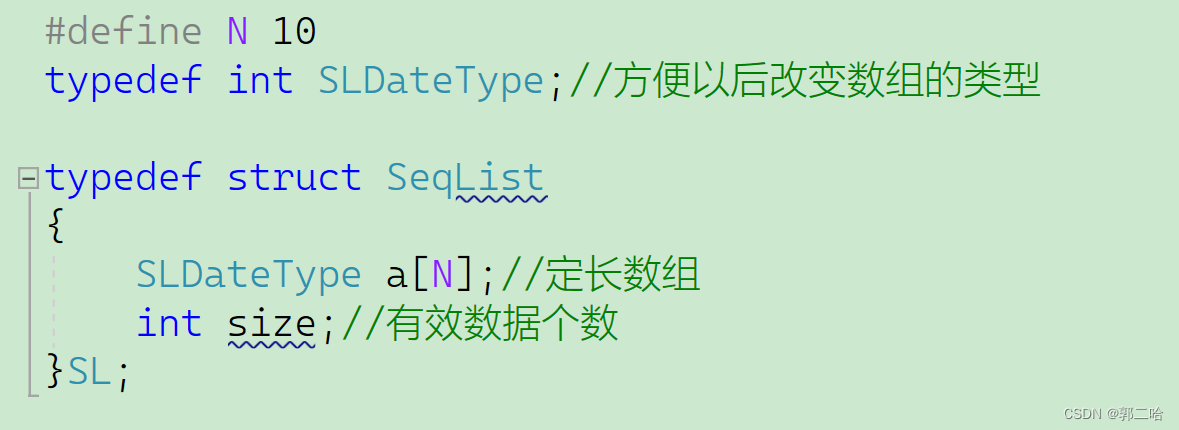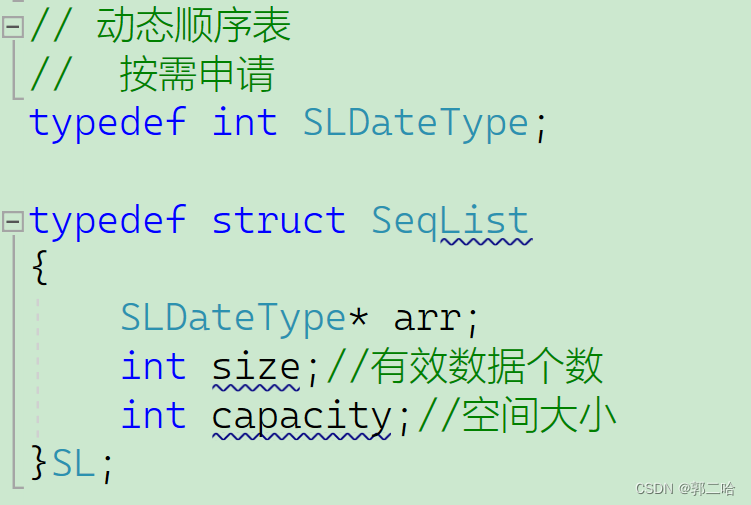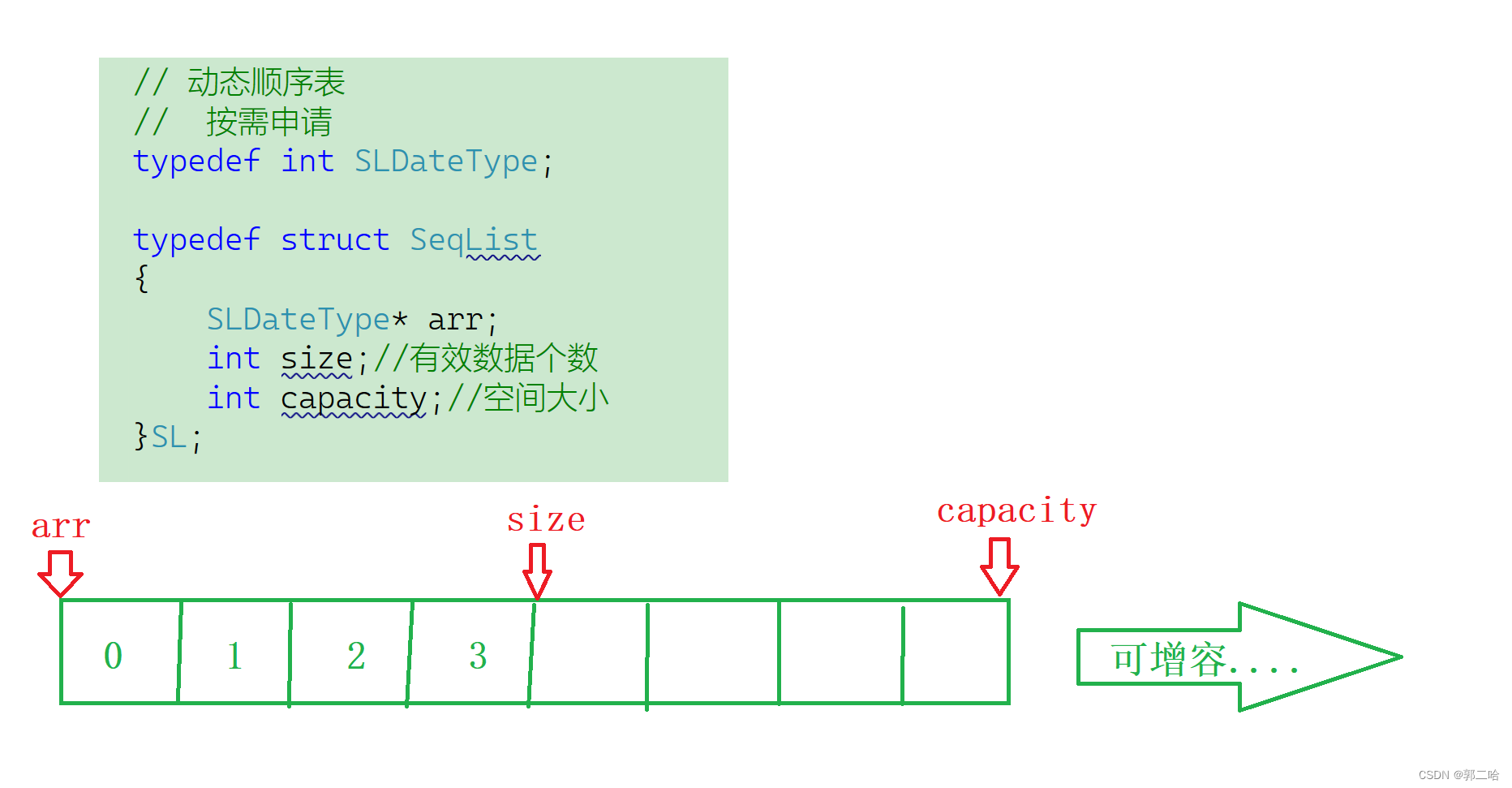一、线性表
线性表(linear list)是n个具有相同特性的数据元素的有限序列。线性表是⼀种在实际中⼴泛使
⽤的数据结构,常⻅的线性表:顺序表、链表、栈、队列、字符串…
线性表在逻辑上是线性结构,也就说是连续的⼀条直线。但是在物理结构上并不⼀定是连续的
线性表在物理上存储时,通常以数组和链式结构的形式存储
二、顺序表
顺序表和数组的区别
顺序表的底层结构是数组,对数组的封装,实现了常⽤的增删改查等接口
顺序表的分类
1.静态顺序表
概念:使⽤ 定⻓数组 存储元素


静态顺序表缺陷:空间给少了不够⽤,给多了造成空间浪费
2.动态顺序表
动态顺序表就是动态分配内存,可以根据需求调节数组大小


三、动态顺序表的实现
实现的主要思想:
1.初始化顺序表:先初始化arr为NULL,size为0,capacity为0
2.销毁顺序表:顺序表使用完成之后,把arr动态分配的内存释放掉
3.扩容顺序表:在每次插入数据之前必须先检查是否空间充足,不足则开辟更大的空间
4.增删查改顺序表:围绕数组去做即可,比较简单。增:头插,尾插,指定位置插入;删:包括头删,尾删,指定位置删除;查找数据。
1.动态顺序表头文件
#pragma once
#define _CRT_SECURE_NO_WARNINGS 1
#include <stdio.h>
#include <stdlib.h>
#include <assert.h>
// 动态顺序表
// 按需申请
typedef int SLDateType;
typedef struct SeqList
{
SLDateType* arr;
int size;//有效数据个数
int capacity;//空间大小
}SL;
void SLInit(SL* ps);//顺序表的初始化
void SLDestroy(SL* ps);//顺序表的销毁
void SLPrint(SL* ps);//顺序表的打印
void SLCheckCapacity(SL* ps);//扩容
//头部插入删除 / 尾部插入删除
void SLPushFront(SL* ps, SLDateType x);
void SLPushBack(SL* ps, SLDateType x);
void SLPopFront(SL* ps);
void SLPopBack(SL* ps);
//指定位置之前插入/删除数据
void SLInsert(SL* ps, int pos, SLDateType x);
void SLErase(SL* ps, int pos);
//查找数据
int SLFind(SL* ps, SLDateType x);
2.动态顺序表源文件
#include "Seqlist.h"
//初始化
void SLInit(SL* ps)
{
ps->arr = NULL;
ps-> size = 0;
ps->capacity = 0;
}
//销毁
void SLDestroy(SL* ps)
{
if (ps->arr)
{
free(ps->arr);
}
ps->arr = NULL;
ps->size = 0;
ps->capacity = 0;
}
//打印
void SLPrint(SL* ps)
{
for (int i = 0; i < ps->size; i++)
{
printf("%d ", ps->arr[i]);
}
printf("\n");
}
//扩容
void SLCheckCapacity(SL* ps)
{
if (ps->size == ps->capacity)
{
//申请空间
int NewCapacity = ps->capacity == 0 ? 4 : 2 * ps->capacity;
SLDateType* tmp = (SLDateType*)realloc(ps->arr, NewCapacity * sizeof(SLDateType));
if (tmp == NULL)
{
perror("realloc fail!");
exit(1);//直接退出程序
}
ps->arr = tmp;
ps->capacity = NewCapacity;
}
}
//头部插入
void SLPushFront(SL* ps, SLDateType x)
{
assert(ps);
SLCheckCapacity(ps);
for (int i = ps->size-1;i >= 0;i--)
{
ps->arr[i + 1] = ps->arr[i];
}
ps->arr[0] = x;
ps->size++;
}
//尾部插入
void SLPushBack(SL* ps, SLDateType x)
{
assert(ps);
SLCheckCapacity(ps);
ps->arr[ps->size++] = x;
}
//头部删除
void SLPopFront(SL* ps)
{
assert(ps);
assert(ps->size);
for (int i = 0;i < ps->size-1;i++)
{
ps->arr[i] = ps->arr[i + 1];
}
ps->size--;
}
//尾部删除
void SLPopBack(SL* ps)
{
assert(ps);
assert(ps->size);
ps->size--;
}
//在指定位置之前插入数据
void SLInsert(SL* ps, int pos, SLDateType x)
{
assert(ps);
assert(pos >= 0 && pos <= ps->size);
SLCheckCapacity(ps);
for (int i = ps->size-1;i >= pos;i--)
{
ps->arr[i+1] = ps->arr[i];
}
ps->arr[pos] = x;
ps->size++;
}
//指定位置之前删除数据
void SLErase(SL* ps, int pos)
{
assert(ps);
assert(pos >= 0 && pos < ps->size);
for (int i = pos;i < ps->size-1;i++)
{
ps->arr[i] = ps->arr[i + 1];
}
ps->size--;
}
//查找数据
int SLFind(SL* ps, SLDateType x)
{
assert(ps);
for (int i = 0; i < ps->size; i++)
{
if (ps->arr[i] == x)
{
return i;
}
}
return -1;
}
3.测试源文件
最后可以在创建一个测试源文件去测试顺序表的正确性
#include "Seqlist.h"
void test()
{
SL s1;
//测试初始化
SLInit(&s1);
//测试尾部插入
SLPushBack(&s1, 1);
SLPushBack(&s1, 2);
SLPushBack(&s1, 3);
SLPushBack(&s1, 4);
SLPushBack(&s1, 5);
//测试打印
SLPrint(&s1);
//测试头部插入
/*SLPushFront(&s1, 9);
SLPushFront(&s1, 8);
SLPushFront(&s1, 7);
SLPushFront(&s1, 6);
SLPushFront(&s1, 66);*/
//测试头删
/*SLPopFront(&s1);
SLPrint(&s1);
SLPopFront(&s1);
SLPrint(&s1);
SLPopFront(&s1);
SLPrint(&s1);
SLPopFront(&s1);
SLPrint(&s1);
SLPopFront(&s1);
SLPrint(&s1);
SLPopFront(&s1);
SLPrint(&s1);*/
//测试尾删
/*SLPopBack(&s1);
SLPrint(&s1);
SLPopBack(&s1);
SLPrint(&s1);
SLPopBack(&s1);
SLPrint(&s1);
SLPopBack(&s1);
SLPrint(&s1);
SLPopBack(&s1);
SLPrint(&s1);
SLPopBack(&s1);
SLPrint(&s1);*/
//测试在指定位置之前插入数据
/*SLInsert(&s1, 3, 8);
SLPrint(&s1);*/
//测试在指定位置之前删除数据
/*SLErase(&s1, 1);
SLPrint(&s1);*/
//测试查找
int find = SLFind(&s1, 3);
if (find != -1)
{
printf("找到了!下标为%d\n", find);
}
else
{
printf("没有找到\n");
}
//测试销毁
SLDestroy(&s1);
}
int main()
{
test();
return 0;
}